 |
|
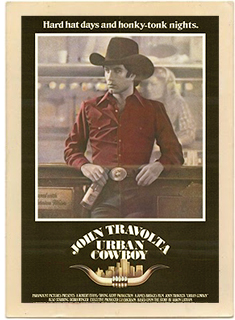 Urban Cowboy Urban Cowboy1980. Paramount Pictures, Paramount Home Video, Color, Aspect Ratio 2.35 : 1, 132 minutes, Rated PG Release Date: June 6, 1980 Urban Cowboy is available at Amazon.com on DVD, as part of The Travolta Collecton DVD Set, and on VHS. Movie Synopsis: A young country boy moves to Houston, Texas, works in the oil industry, and gets it on at Gilley’s nightclub every night, where he finds love and a few other complicated situations. Cast: John Travolta, Debra Winger, Scott Glenn, Barry Corbin, Brooke Alderson, Mickey Gilley, Johnny Lee, Bonnie Raitt, Charlie Daniels Director: James Bridges Thoughts on the Movie: I don’t have anything bad to say about Urban Cowboy, and yet, there is something about this movie that leaves me a little off balance. I don’t know what it is. The film is well-cast, the performances are great, the setting is perfect, and the music fits seemlessly with all of the above. Maybe it’s because in some odd way, it just doesn’t completely feel like Texas to me. Perhaps it’s the “urban” part of the equation, and the fact that we’re talking about Houston, which is a city, but it’s not really what most people would think of as a truly urban landscape. Nevertheless, I love John Travolta in his role as Bud Davis. This guy is as dumb as a stick, but you can’t help but love him and always end up being on his side. The supporting characters are true to life and really make the movie sing. And I loved the dancing... it was such a breath of fresh air after having lived through so much disco. But to get back to what I said at the beginning of this, maybe I do know what bugs me about Urban Cowboy: I lived in Oklahoma and traveled to Texas (including Houston) quite a bit in my youth, and you know what?... not that many people I knew (or saw) wore cowboy hats. It’s sort of a misconception, like if you come from that part of the country you probably never heard rock and roll. And even if I’m right about that (the cowboy hat thing), I do like the way they played that up in the movie. It was fun, and colorful, and rather groovy. ~Jean 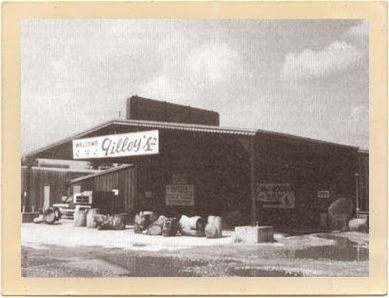 Location Site: Location Site:Gilley’s Nightclub, Pasadena, Texas (see Map) Gilley’s was located at 4500 Watters Road, Pasadena, Texas. Today, the property is vacant and is owned by the Pasadena School District. However, you can still go to the location and look at where the historic nightclub used to sit. The bar was founded in 1971, after Sherwood Cryer discovered Mickey Gilley singing at a Pasadena club where he was making so little money he could barely pay his three-member band. Cryer asked Gilley, “How would you like to have a club of your own?” Right: This faded, black and white photo is the only one I could find of Gilley’s night club during its years of operation. With Cryer running the club and Gilley performing, the venue became a hot spot to refinery workers who risked their lives during the day, then donned cowboy boots and Stetsons to dance the two-step and ride the mechanical bull. Gilley’s also pulled in some of the biggest country acts of the day, from Loretta Lynn to Alabama, and it made Mickey Gilley a star. Gilley’s had a shooting gallery, showers for truckers, a rodeo arena with mechanical bulls, pool tables, punching bags, and a dance floor big enough for hundreds. It had a 6,000-person capacity and is listed in the Guinness Book of World Records as the world’s largest honky-tonk. In its heyday, Gilley’s was open seven days a week from 10:00 a.m. to 2:00 a.m. 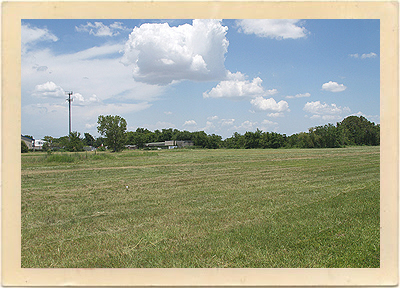 Esquire did a cover piece on Gilley’s titled, “The Ballad of the Urban Cowboy,” and Paramount bought the rights. They planned to shoot the movie in Hollywood, but Cryer was instrumental in keeping the filming at the actual club in Pasadena. He convinced the filmmakers they would never duplicate the atmosphere anywhere else. The movie made Gilley’s a tourist attraction and Cryer sold mechanical bulls to bars across the country. But the hype ruined the club for Gilley’s regulars and started a rift between Cryer and Gilley. Esquire did a cover piece on Gilley’s titled, “The Ballad of the Urban Cowboy,” and Paramount bought the rights. They planned to shoot the movie in Hollywood, but Cryer was instrumental in keeping the filming at the actual club in Pasadena. He convinced the filmmakers they would never duplicate the atmosphere anywhere else. The movie made Gilley’s a tourist attraction and Cryer sold mechanical bulls to bars across the country. But the hype ruined the club for Gilley’s regulars and started a rift between Cryer and Gilley.Left: A vacant pasture, awaiting new construction, is the site where the world-famous Gilley’s night club once stood. It’s hard to believe, but all traces of the largest honky-tonk night club in the world have been completely removed from this location. Gilley's is no more. Gilley’s closed on March 30, 1989, after Mickey Gilley and Sherwood Cryer (co-owners) went to court. The nightspot burned down later that year, supposedly from arson. The only buildings left standing were the recording studio, indoor rodeo building, and the shed. Since then, the rodeo arena has now been demolished and the land is fenced off. The recording studio also mysteriously burned down and that property has been overrun by brush. There is nothing left on the original location that anybody would recognize as Gilley’s. But the restored Gilley’s sign can be seen about a mile away at the Cowboy Ranch restaurant. 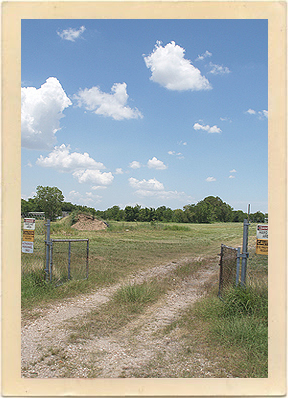 About Pasadena, Texas: About Pasadena, Texas:Pasadena, Texas (population 152,968, elevation 30 feet; 29° 40’ 34” N, 95° 10’ 26” W) is located in the Houston metropolitan area on State Highway 249 (in the southeast part of the state on the Gulf of Mexico). In 1843, Sam Allen established a ranch with 350 acres. This became the Allen Ranch, which occupied what is now western Pasadena, and all the way to Harrisburg, Texas. Right: The gate to the entrance of the vacant property where Gilley’s, the largest honky-tonk in the world, once stood, in Pasadena, Texas. Proposed towns in or near present day Pasadena were set up, but short lived and abandoned, or they never even got off the ground. In 1892, Colonel John H. Burnett of Galveston, established an unnamed townsite just east of the Allen Ranch. Burnett was involved in both construction and promotion of railroads and knew their impact on the value of property. The land was sold in 10 acres lots. He had also established the nearby towns of Deepwater and Genoa, later to be incorporated into Pasadena and Houston. In 1901, the “Texas Oil Boom” began and by 1920, refinery operations had appeared in Pasadena and that industry would continue to expand. Today, the city’s key economic sectors still revolve around exploration for petroleum and gas, petroleum refining, and petrochemical processing. 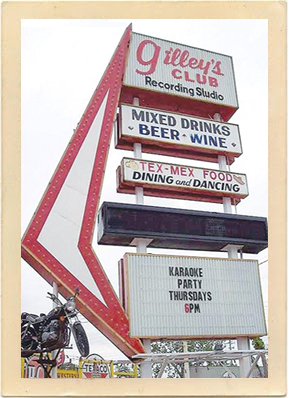 Lodging & Dining: Lodging & Dining:Silver Sycamore Bed & Breakfast. 5111 Pine Avenue, Pasadena, Texas The Silver Sycamore property boasts lush gardens and water features, a wedding and reception facility, a bridal cottage, and a quaint “Texas” tearoom. It has been called the “Best Kept Secret in Pasadena, Texas.” Mamacita’s. 7325 Spencer Highway, Pasadena, Texas Oversized portions of authentic Mexican dishes and the best Margaritas in the area. The menu also offers many vegetarian selections. There are two other locations in Woodland and Houston, Texas. Awards: • Debra Winger was nominated for two Golden Globes: 1) Best Motion Picture Actress in a Supporting Role, and 2) New Star of the Year in a Motion Picture–Female Left: The sign outside Gilley’s night club during its heydey in the 1970s. Movie Trivia: • John Travolta had a mechanical bull installed in his home two months before production began. He became so good that he was allowed to dismiss the stunt double and do the bullriding takes himself. • At the time the film was shot, Gilley’s, used as the film’s main nightclub location, was the largest nightclub in the world in square feet, according to the Guinness Book of World Records. • Patrick Swayze’s wife and mother (Lisa Niemi and Patsy Swayze) choreographed the dance sequences. And Patrick Swayze taught John Travolta how to do the two-step for the movie. 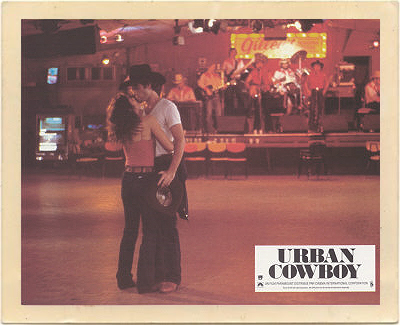 • The soundtrack album was a major hit. It sold several million copies and featured the hit tunes Looking for Love, Can I Have This Dance? and All Night Long. • The soundtrack album was a major hit. It sold several million copies and featured the hit tunes Looking for Love, Can I Have This Dance? and All Night Long.• After initial box-office returns were surprisingly low, a newspaper poll was taken in the summer of 1980 to figure out why teenagers were not flocking to see the film. One of the main complaints from kids was that they did not know what the word “urban” meant. Right: John Travolta and Debra Winger get intimate on the enormous dance floor at Gilley’s night club, in a scene from the movie, “Urban Cowboy.” Character Quote: “All cowboys ain’t dumb. Some of ‘em got smarts real good, like me.” ~Bud Davis (John Travolta) |
|